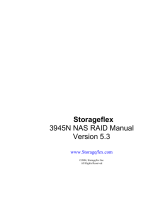
Viewing Local Groups......................................................................................................................................58
Adding A Local Group......................................................................................................................................58
Deleting A Local Group....................................................................................................................................59
Authentication........................................................................................................................................................59
Configuring An Identity Management Database..............................................................................................59
Enabling User Authentication Through An NIS Database...............................................................................59
Enabling User Authentication Through An LDAP Database............................................................................60
Disabling The Use Of An External UNIX Identity Management Database.......................................................60
Active Directory......................................................................................................................................................60
Synchronizing The NAS Cluster Solution With The Active Directory Server.........................................................60
Configuring The Active Directory Service........................................................................................................60
Network Configuration Overview...........................................................................................................................61
Performance And Static Routes.......................................................................................................................62
Configuring DNS.....................................................................................................................................................63
Viewing DNS Servers.......................................................................................................................................63
Adding DNS Servers And DNS Suffixes...........................................................................................................63
Removing DNS Servers And DNS Suffixes......................................................................................................63
Managing Static Routes.........................................................................................................................................63
Viewing Static Routes......................................................................................................................................64
Adding Static Routes........................................................................................................................................64
Modifying A Static Route.................................................................................................................................64
Deleting A Static Route....................................................................................................................................64
Defining File System Protocols...............................................................................................................................64
Configuring CIFS Parameters.................................................................................................................................65
Configuring General CIFS Parameters.............................................................................................................65
Denying Users From Accessing Files Using The CIFS Protocol ......................................................................65
Configuring Advanced CIFS Parameters..........................................................................................................65
Configuring System Time Parameters....................................................................................................................66
Changing The Time Zone..................................................................................................................................66
Manually Configuring The Current Date And Time..........................................................................................66
Removing An NTP Server.................................................................................................................................66
Synchronizing The NAS Cluster Solution With A Local NTP Server................................................................67
Managing Licenses.................................................................................................................................................67
Viewing Licenses.............................................................................................................................................67
Adding A License.............................................................................................................................................67
Removing A License.........................................................................................................................................67
Configuring E-mail Parameters On PowerVault NX3500/NX3600/NX3610 NAS Solutions......................................68
Viewing SMTP Servers....................................................................................................................................68
Configuring An SMTP Server...........................................................................................................................68
Modifying An SMTP Server Configuration.......................................................................................................69
Delete An E-mail Sender..................................................................................................................................69
Configuring An E-mail Sender..........................................................................................................................69




















